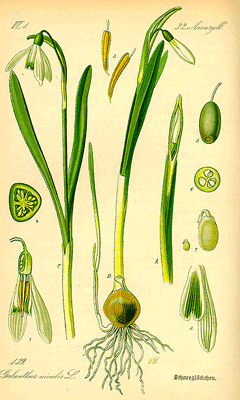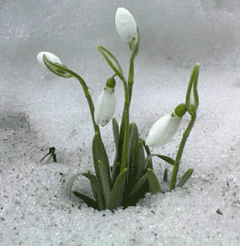 |
|
http://commons.wikimedia.org/wiki/File:Illustration_Galanthus_nivalis0.jpg |
 |
|
Translate this page:
Summary
Bloom Color: White. Main Bloom Time: Early spring, Late winter, Mid winter. Form: Upright or erect.
Physical Characteristics

 Galanthus nivalis is a BULB growing to 0.2 m (0ft 8in) by 0.1 m (0ft 4in) at a medium rate.
Galanthus nivalis is a BULB growing to 0.2 m (0ft 8in) by 0.1 m (0ft 4in) at a medium rate.
See above for USDA hardiness. It is hardy to UK zone 4 and is not frost tender. It is in leaf from January to June, in flower from February to March, and the seeds ripen from May to June. The species is hermaphrodite (has both male and female organs) and is pollinated by Bees.
Suitable for: medium (loamy) and heavy (clay) soils. Suitable pH: mildly acid, neutral and basic (mildly alkaline) soils. It can grow in semi-shade (light woodland). It prefers moist soil.
UK Hardiness Map
US Hardiness Map
Synonyms
Plant Habitats
Woodland Garden Dappled Shade; Shady Edge; Meadow;
Edible Uses
References More on Edible Uses
Medicinal Uses
Plants For A Future can not take any responsibility for any adverse effects from the use of plants. Always seek advice from a professional before using a plant medicinally.
Emmenagogue
The plant is emmenagogue[4].
References More on Medicinal Uses
The Bookshop: Edible Plant Books
Our Latest books on Perennial Plants For Food Forests and Permaculture Gardens in paperback or digital formats.

Edible Tropical Plants
Food Forest Plants for Hotter Conditions: 250+ Plants For Tropical Food Forests & Permaculture Gardens.
More

Edible Temperate Plants
Plants for Your Food Forest: 500 Plants for Temperate Food Forests & Permaculture Gardens.
More

More Books
PFAF have eight books available in paperback and digital formats. Browse the shop for more information.
Shop Now
Other Uses
References More on Other Uses
Cultivation details
Landscape Uses:Alpine garden, Border, Container, Foundation, Massing, Rock garden, Woodland garden. Prefers a moist heavy loam[108], growing well in grass or amongst shrubs[1]. Prefers a shady position[28, 31]. The dormant bulbs are fairly hardy and will withstand soil temperatures down to at least -5°c[214]. A very ornamental plant[1], it grows well on the woodland edge[24]. The bulbs should be planted about 5 - 7cm deep as early in the spring as possible[1]. A good bee plant, providing an early source of pollen and nectar[108]. Special Features:Not North American native, Naturalizing, All or parts of this plant are poisonous, Fragrant flowers.
References Carbon Farming Information and Carbon Sequestration Information
Temperature Converter
Type a value in the Celsius field to convert the value to Fahrenheit:
Fahrenheit:
The PFAF Bookshop
Plants For A Future have a number of books available in paperback and digital form. Book titles include Edible Plants, Edible Perennials, Edible Trees,Edible Shrubs, Woodland Gardening, and Temperate Food Forest Plants. Our new book is Food Forest Plants For Hotter Conditions (Tropical and Sub-Tropical).
Shop Now
Plant Propagation
Seed - best sown as soon as it is ripe in a cold frame[1]. Sow the seed thinly so that there is no need to thin them. The seed usually germinates in the spring[1]. Grow them on in the same pot in a cold frame for the first two years, giving an occasional liquid feed to ensure the plants do not become nutrient deficient. Pot up the small bulbs whilst they are still in leaf in early summer of their second year's growth, putting about 3 bulbs in each pot. Grow them on in the cold frame for a further year before planting them out into their permanent positions in late spring whilst they are still in growth. The plants take about 4 years to flower from seed[200]. Division of offsets[1, 200]. This is best done immediately after the plants have finished flowering (and still have green leaves) though it can also be done in late summer and early autumn when the plants are dormant[200]. Scooping.
Other Names
If available other names are mentioned here
Native Range
TEMPERATE ASIA: Russian Federation-Ciscaucasia (Ciscaucasia) EUROPE: Austria, Switzerland, Czech Republic, Germany, Hungary, Poland, Slovakia, Moldova, Ukraine, Former Yugoslavia, Albania, Bulgaria, Greece (n. & Kastellorizo Island), Italy (incl. Sicily), Romania, Turkey (Istanbul), Spain (northeast), France
Weed Potential
Right plant wrong place. We are currently updating this section.
Please note that a plant may be invasive in one area but may not in your area so it's worth checking.
Conservation Status
IUCN Red List of Threatened Plants Status :

Growth: S = slow M = medium F = fast. Soil: L = light (sandy) M = medium H = heavy (clay). pH: A = acid N = neutral B = basic (alkaline). Shade: F = full shade S = semi-shade N = no shade. Moisture: D = dry M = Moist We = wet Wa = water.
Now available:
Food Forest Plants for Mediterranean Conditions
350+ Perennial Plants For Mediterranean and Drier Food Forests and Permaculture Gardens.
[Paperback and eBook]
This is the third in Plants For A Future's series of plant guides for food forests tailored to
specific climate zones. Following volumes on temperate and tropical ecosystems, this book focuses
on species suited to Mediterranean conditions—regions with hot, dry summers and cool, wet winters,
often facing the added challenge of climate change.
Read More
Expert comment
Author
L.
Botanical References
17200
Links / References
For a list of references used on this page please go here
Readers comment